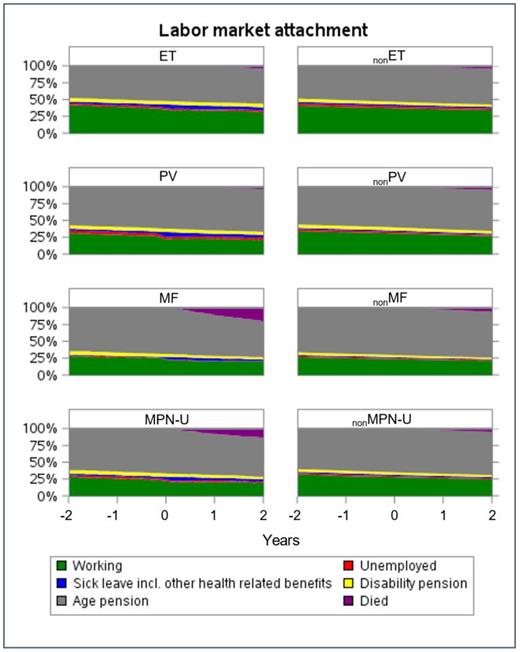Abstract

BACKGROUND
Myeloproliferative neoplasms (MPNs) are characterized by a substantial symptom burden, risk of debilitating complications (e.g., thrombosis), and increased comorbidity. Recently, three comprehensive questionnaire studies (Mesa 2016, Harrison 2017, Jingbo 2018) have reported a high impact of MPNs on patients' ability to work. However, no registry-based studies have assessed labor market attachment (LMA) of MPN patients and matched nonMPN comparisons.
AIM
To assess the pre- and post-diagnostic LMA of MPN patients and matched nonMPN comparisons.
METHODS
We conducted a descriptive, registry-based nationwide cohort study, using data from the Danish National Chronic Myeloid Neoplasia Registry including all Danish MPN patients diagnosed between January 2010 and December 2016. Population-based cohorts of nonMPN comparisons were constructed by 1:10 matching on age, sex, level of education, and region of residence. Data on LMA were retrieved from the Danish Register for Evaluation of Marginalization, which holds information on all public transfer payments in Denmark. Data were linked using the unique civil registration number, which identifies all Danish citizens. The LMA endpoints were defined for each individual as working (not receiving any type of transfer payment), unemployed, receiving transfer payment for either sick leave, disability pension, age pension, or other health-related benefits (e.g., wage-subsidized employment). We assessed LMA weekly for each individual from two years before diagnosis until death, emigration, or two years after the diagnosis. For each cohort, we presented LMA as proportions with 95% confidence intervals (CIs), as well as the proportion of individuals who died during follow-up.
RESULTS
The study included 3,342 MPN patients (1,140 essential thrombocythemia [ET]; 1,109 polycythemia vera [PV]; 533 myelofibrosis [MF]; and 560 unspecified MPN [MPN-U]) and 32,737 nonMPN comparisons (11,181 nonET; 10,873 nonPV; 5,217 nonPMF; and 5,466 nonMPN-U). The median age at time of diagnosis was: ET 67 years (interquartile range [IQR], 55-76); PV, 69 years (IQR, 61-77); PMF, 73 years (IQR, 66-79); and MPN-U, 72 years (IQR, 63-80).
At time of MPN diagnosis, the majority of MPN patients and nonMPN comparisons received age pension (range: ET, 52.1% [95% CI, 49.2-55.0] to nonMF, 70.3% [95% CI, 69.1-71.6]). The proportions working were: ET, 35.1% (95% CI, 32.3-37.9) vs. nonET, 37.3% (95% CI, 36.5-38.2); PV, 22.6% (95% CI, 20.2-25.1) vs. nonPV, 30.8% (95% CI, 29.9-31.7); MF, 23.8% (95% CI, 20.2-27.4) vs. nonMF, 23.6% (95% CI, 22.5-24.8); and MPN-U, 22.1% (95% CI,18.7- 25.6) vs. nonMPN-U, 27.8% (95% CI, 26.6-29.0). Across MPN subtypes, a larger proportion of patients than comparisons were on sick leave: ET, 3.5% (95% CI, 2.4-4.6) vs. nonET, 1.3% (95% CI, 1.1-1.5); PV, 5.5% (95% CI, 4.2-6.8) vs. nonPV, 0.9% (95% CI, 0.7-1.1); MF (not applicable due to small numbers) vs. nonMF, 0.6% (95% CI, 0.4-0.8); and MPN-U, 3.0% (95% CI, 1.6- 4.5) vs. nonMPN-U, 1.0% (95% CI, 0.7-1.3). Regarding disability pension, the proportions ranged from 4.1% (95% CI, 2.4-5.8) to 5.0% (95% CI, 3.7-6.3) among patients and from 3.1% (95% CI, 2.6-3.6) to 4.7% (95% CI, 4.3-5.1) among comparisons. For both MPN patients and nonMPN comparisons, few were unemployed (≤3.3%) or received other health-related benefits (≤1.6%).
Two years preceding diagnosis, the proportion of PV and MPN-U patients working was slightly lower than the matched comparisons: PV, 31.0% (95% CI, 28.4-33.8) vs. nonPV, 34.3% (95% CI, 33.5-35.2) and MPN-U, 28.2% (95% CI, 24.6-32.1) vs. nonMPN-U, 32.0% (95% CI, 30.7-33.2), while this difference was not observed between ET and MF patients and their respective comparisons.
From two years before to two years after diagnosis, we observed slightly larger reductions in the proportion working among MPN patients than among comparisons. Among MPN patients, the proportion on sick leave including other health-related benefits, increased during the study period, while it remained unchanged among comparisons. The proportion of patients and comparisons on disability pension remained stable.
CONCLUSION
Overall, our findings showed that Danish patients with ET, PV, MF, and MPN-U had slightly impaired LMA already two years before diagnosis and up to two years after diagnosis. Thus, fewer patients were working and more patients transferred to sick leave compared with matched individuals without MPN.
Stenling: Novartis: Current Employment. Paulsson: Novartis: Current Employment. Frederiksen: Novartis: Research Funding; Alexion: Research Funding; Gilead: Research Funding; Abbvie: Research Funding; Janssen Pharmaceuticals: Research Funding. Hasselbalch: Novartis, AOP Orphan: Consultancy, Other: Advisory Board.
Author notes
 This icon denotes a clinically relevant abstract
This icon denotes a clinically relevant abstract


This feature is available to Subscribers Only
Sign In or Create an Account Close Modal